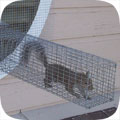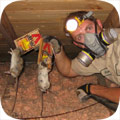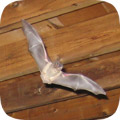- morgancounty@wildlifeanimalcontrol.com
Call 24/7 for a free quote:
801-438-6043
Morgan County Wildlife Animal Control
Professional Wildlife Removal Company Servicing Morgan County, UT
If you have a problem with wildlife in your Morgan County home, your best option is to hire a company that specializes in Utah wildlife removal only. This is a specialty business, and regular pest control companies do not use the proper techniques to solve animal problems. I have spent many years reviewing Utah and Morgan County, and I recommend the following:
Complete Wildlife Removal
Cell Phone: 801-438-6043
NOTE: If you have a dog or cat problem, call the County Animal Services: (801) 444-2200

Complete Wildlife Removal specializes primarily in removing animals from attics of homes and buildings - this includes squirrels in attics, raccoons, and rats or mice in homes. Utah also has a documented problem with
bats in buildings, and Complete Wildlife Removal is specially trained in bat removal. They also perform general wildlife trapping services, such as the capture and removal of skunks or opossums on the
property. Call 801-438-6043 to discuss your critter problem and schedule a same-day or next-day appointment. Click here to learn more about what prices we charge in 2020.
When hiring a company to solve your wild animal problem, you want these features:
- Specializes in wildlife removal, not pest control
- Fully Utah and the County licensed and insured
- Works 7 days per week (critters don't take weekends off)
- Performs full building inspections: enters and inspects attic
- Performs exclusion repairs, with guarantee against animal re-entry
- Offers cleanup of biohazardous wildlife waste
Complete Wildlife Removal is a full-service Morgan County wildlife removal company. This is very different from a regular Morgan County pest control company. The pest control companies spray poison to kill insects. This is not at all
similar to wildlife removal. Complete Wildlife Removal performs a full inspection of the home or property, and determines why the animal(s) are there, and if inside a building, how the animals got inside. All
animals (including rodents) are trapped and removed, or if possible, removed from the building using special exclusion devices. Once the animals are gone, preventative repairs are essential, and
cleanup is sometimes recommended.
 Morgan County wildlife trapping - it's not as simple as it may seem. It's illegal in Utah to trap without a license. Trap type is very important and there are many different types, bait is somewhat relevant, trap placement
is vital, and there are dozens of small things that are very important to know.
Safety is a concern. Then once the animal is trapped, it must be removed and dealt with in the proper manner according to Utah law. We offer Morgan County raccoon removal. Read more about how to get rid of raccoons.
Morgan County wildlife trapping - it's not as simple as it may seem. It's illegal in Utah to trap without a license. Trap type is very important and there are many different types, bait is somewhat relevant, trap placement
is vital, and there are dozens of small things that are very important to know.
Safety is a concern. Then once the animal is trapped, it must be removed and dealt with in the proper manner according to Utah law. We offer Morgan County raccoon removal. Read more about how to get rid of raccoons.
 Animals in attics - this is our specialty at Complete Wildlife Removal. Many types of animals like to live in attics. This includes squirrels, raccoons, rats, mice, bats, birds, and even possums. Critters like to go into attics for a safe place to live
and raise their young. Removing animals from attics is very complex work, partly because of the presence of baby animals. If you need Morgan County squirrel removal, we can remove all the squirrels from your attic, and seal out any future ones. Read more about how to get rid of squirrels.
Animals in attics - this is our specialty at Complete Wildlife Removal. Many types of animals like to live in attics. This includes squirrels, raccoons, rats, mice, bats, birds, and even possums. Critters like to go into attics for a safe place to live
and raise their young. Removing animals from attics is very complex work, partly because of the presence of baby animals. If you need Morgan County squirrel removal, we can remove all the squirrels from your attic, and seal out any future ones. Read more about how to get rid of squirrels.
 Rodent control must be done in a very specific way. First off, the most important thing is that all the openings that rats and mice can use to enter a house be sealed. Then all the rodents must be physically trapped and removed.
Never, ever use poison! Most Morgan County exterminators will just use this lazy poison technique to kill rodents, and it causes more harm than good - dead stinky rats, and it doesn't solve the problem. Call us for correct Morgan County rat removal. Read more about how to get rid of rats.
Rodent control must be done in a very specific way. First off, the most important thing is that all the openings that rats and mice can use to enter a house be sealed. Then all the rodents must be physically trapped and removed.
Never, ever use poison! Most Morgan County exterminators will just use this lazy poison technique to kill rodents, and it causes more harm than good - dead stinky rats, and it doesn't solve the problem. Call us for correct Morgan County rat removal. Read more about how to get rid of rats.
 Bat removal is a highly specialized task. Utah is known to have colonizing bats who often live in buildings. Bats love attics. If not removed, the colony can grow to a very large size over the years. The bat droppings are often corrosive and
cause health risks. The same goes for bird droppings on or in buildings. We perform Morgan County pigeon removal and bird control. But our specialty is Morgan County bat removal. We remove 100% of the bat colony and seal the building so that it's totally bat-proof. Read more about how to get rid of bats.
Bat removal is a highly specialized task. Utah is known to have colonizing bats who often live in buildings. Bats love attics. If not removed, the colony can grow to a very large size over the years. The bat droppings are often corrosive and
cause health risks. The same goes for bird droppings on or in buildings. We perform Morgan County pigeon removal and bird control. But our specialty is Morgan County bat removal. We remove 100% of the bat colony and seal the building so that it's totally bat-proof. Read more about how to get rid of bats.
 If you have animals inside a house, no job is complete without proper exclusion repairs. If you simply hire a Morgan County trapper who only removes the critters, then the problem will return. You need to hire a Morgan County wildlife control company that identifies 100% of the animal entry points
into your building, and seals them shut with professional repairs. In addition, in many cases animals have left waste or contamination behind, and you'll want a company that can provide professional cleaning services. Complete Wildlife Removal does both.
If you have animals inside a house, no job is complete without proper exclusion repairs. If you simply hire a Morgan County trapper who only removes the critters, then the problem will return. You need to hire a Morgan County wildlife control company that identifies 100% of the animal entry points
into your building, and seals them shut with professional repairs. In addition, in many cases animals have left waste or contamination behind, and you'll want a company that can provide professional cleaning services. Complete Wildlife Removal does both.
The above are just some of the services offered by Complete Wildlife Removal. We also trap and remove animals that destroy lawns, such as moles, or digging animals. Sometimes animals like opossums will live under buildings, steal pet food, raid garbage cans, etc.
Read about how to get rid of opossums. Skunks commonly live under sheds or decks, and set up a den. We can trap and remove them without them spraying. Read about how to get rid of skunks. Complete Wildlife Removal
also provides dead animal removal in Morgan County. If you need help with any other wildlife conflict, from a fox, beaver, groundhog, or any other critter, we can solve it. We also do Morgan County snake removal - most of the snakes in Utah are not venomous, but
call us if you want safe removal, or read about how to get rid of snakes in Morgan County. And remember, we are a private business, not the County Animal Control Services, so if you have a dog or cat problem, call the County at (801) 444-2200.
the County animal services does not handle any wildlife issues.
Complete Wildlife Removal: 801-438-6043
Morgan County Pricing Info For Year 2020
 Every wildlife removal situation is different, from the species of animals involved, the location of the animal inside a house or outside, the extent of repairs or cleanup, etc. It's impossible to give one-size-fits-all prices. Examples MIGHT include:
Every wildlife removal situation is different, from the species of animals involved, the location of the animal inside a house or outside, the extent of repairs or cleanup, etc. It's impossible to give one-size-fits-all prices. Examples MIGHT include:
Small Job: For example, a one-stop job to remove an animal in the yard: $100 on up
Medium Job: For example, getting critters out of your house with minor repairs: $300 on up
Large Job: For example, a project involving many service trips and complex work: $500 on up
Give us a phone call now and tell us about your wildlife issue and we will be able to give you a price estimate over the phone. If you're cool with it, we can schedule a same-day or next-day appointment if you like. Our prices are fair, and a good value because we do the job right, the first time.
Morgan County Wildlife Tip #1:
What Are Some Of The Symptoms Of A Sick Bat?
If you see a bat flying during the day or a bat fallen on the ground it is not necessary that they are sick. There are times when there are storms and in order to fight the harsh breeze their wings are exhausted. Do not try and touch them, use a delicate branch and put them up on the tree or a higher ground, once they are ok they will fly away. However if you notice that they haven't flown for quite some time call a rehabilitator, they will take care of them.
Bats are harmless creatures but if touched they might bite in defence. It is best for you not to touch them with bare hands and also teach your children the same. Bats might be affected by rabies; the signs may not be quite visible to the humans however there are certain clinical symptoms by which rabies is determined. Infected bats might behave more aggressive than the others. Difficulty in flying or hanging and disorientation. Eyes with staring expression.
White Nose Syndrome (WNS) seems to have killed many bats. This disease is caused by a fungus that grows on their nose, wings and ears. This normally happens during their hibernation. This fungus penetrates the skin of the bats and causes extensive damage. Affected bats will arouse from their sleep many times which burns up their fats necessary for hibernation. The fungus is contagious and spreads among the bats on contact and to the humans also if any contact is made. Some of the clinical symptoms of WNS are as follows. A presence of a white powdery substance on the bats nose, ears and wings. Especially during winters when it is time for them to hibernate. Loss of flight and damaged wings. Unusual activity during winter, when they are supposed to be hibernating they are seen flying outside. Emaciation and dehydration; they will look weal and thin.
Bats are famous to be bearers of many diseases and touching them with your bare hands might not be a good idea. Whether a bat is healthy or looks weak or injured, if you seem to have located one in your garden or home; irrespective of the fact that you recognise any of the symptoms mentioned above. It is best that you do not try helping them especially with your bare hands. You should get in touch with a wildlife rehabilitator. They are well equipped to handle bats and trained to take care of them.
Morgan County Wildlife Tip #2:
Utah Wildlife Information:
Utah State bird: California gull
State mammal: Rocky Mountain elk
State fish: Bonneville cutthroat trout
State insect: European honey bee
Utah is one of the few states with enough of a variety in landscape to support multiple large and small animals. While the region tends to be warm and dry for the summer and cold and dry during the winter, some of the mountain regions receive ample snow. The snowfall is so good, in fact, that many of the ski resorts in the state are renowned for their light, powdery snow. The state is dry because of the placement of mountains in neighboring locations. These tall peaks create what is called a rainfall shadow, meaning most of the moisture is gone before it reaches mainland Utah. Much of the land is arid for this reason, with tall mesas and sandstone formations. Pine forests are lovely in the river valleys, and are another reason why the state can support so much life.
Utah has a number of large creatures walking through the wilderness. There are desert bighorn sheep, Rocky Mountain bighorn sheep, elk, moose, pronghorns, mule deer, bison, white-tailed deer, and mountain goats. These large grazers are accompanied by large predators include grizzly bears, black bears, mountain lions, and gray wolves. Smaller predators are also abundant, and Utah has both bobcats and Canadian lynx. Coyotes tend to be a presence in most of the nation, and Utah is no exception. While these canines won't compete with wolves for food, they have a wide variety of meal options in the desert areas and lower woodlands.
Small creatures abound in the warm, dry climate. The arid regions boast numerous reptiles, one of the most famous being the Gila monster. Gila monsters feed primarily on eggs from birds and other reptiles. Several species of rattlesnakes are common throughout the state. The snakes, accompanied by many non-venomous serpents, spend their time feeding on the more than adequate variety of rodents in Utah.
The region has small rodents like brush mice, black rats, cactus mice, kangaroo mice, desert shrews, and desert woodrats.
The deserts are home to a small rabbit called the pygmy rabbit, the result of an evolutionary shrinking process likely due to scarce water supply. The rabbit is just the first in a list of common nuisance animals including raccoons, ringtails, mice, squirrels, muskrats, nutria, and beavers.
You can always call Complete Wildlife Removal, any time of day, at 801-438-6043, for a price quote for Morgan County wildlife control services. I am confident that this is the best choice amongst wildlife removal companies in Morgan County, UT.





































